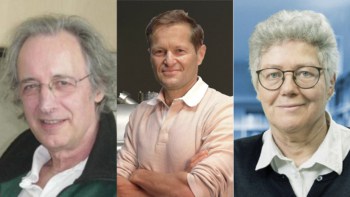
A new type of structure for converting red light into blue has been unveiled by researchers in the US. Known as frequency doubling or second-harmonic generation (SHG), the conversion involves “nanocups”, which are tiny, artificially designed 3D structures. SHG is used in light sources and in metrology applications – and the researchers believe that the new structures could be adapted to achieve frequency doubling in parts of the electromagnetic spectrum where it is currently not possible.
SHG is a nonlinear optical process whereby two similar photons are converted into a single photon with twice the energy – and therefore twice the frequency or half the wavelength – of the initial photons. The process was first demonstrated in 1961 when researchers focused a ruby laser with a wavelength of 694 nm into a quartz sample and observed that the light that was subsequently emitted had a wavelength of 347 nm.
Today, SHG is typically produced in nonlinear media, such as certain optical crystals, and the effect is widely used by the laser industry, for example, to make green 532 nm lasers from a 1064 nm source.
Heroes of the half-shell
Now, Naomi Halas and colleagues at Rice University in Houston have designed a new nonlinear optical structure for frequency doubling. Called a nanocup (or half-shell), it consists of a hemispherical nanoparticle of radius 60 nm made of a non-conducting silica. A 35 nm-thick layer of gold is deposited onto the hemisphere’s convex surface to create a cup-like structure. Such nanocups have “plasmonic resonances”, which are collective oscillations of the metal’s conduction electrons that can strongly interact with light at certain frequencies.
Halas’ team has shown that the nanocups respond to both the electric- and magnetic-field components of light, and possess unique light-refractive properties. The Rice researchers succeeded in generating second-harmonic ultraviolet light from individual nanocups by tuning the magnetic plasmon resonance to the incoming laser light with a wavelength of 800 nm. They also found that they could increase the intensity of the SHG by tilting the nanocup with respect to the incoming laser light. The outgoing SHG signal at 400 nm was collected and analysed using a CCD camera. The team observed that the intensity of the SHG increases as the angle between the incident beam and the symmetry axis of the nanocup is increased (see figure).
Inaccessible wavelengths
“Our technique generates frequency-doubled light at efficiencies equivalent to those produced by conventional nonlinear optical crystals with the same thickness,” says Halas. “Our work on nanocups could lead to the development of other, similar types of nonlinear optical materials that are designed to work at specific wavelengths of light, say in the infrared or ultraviolet, or at wavelengths that are currently inaccessible to existing nonlinear optical materials.”
According to the team, photonic devices, such as optical parametric oscillators or amplifiers and electro-optic or acousto-optic modulators, could be made using these types of structures. The nanocups could also be integrated into silicon photonics for on-chip optical sources or for measurements in future work.
The research is detailed in Nano Lett. 10.1021/nl2033602.



